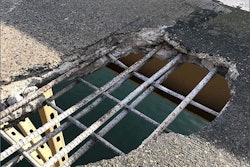 Drexel University researchers develop spherical porous reactive aggregate (SPoRA) made from coal ash. Photo courtesy Drexel University.
Drexel University researchers develop spherical porous reactive aggregate (SPoRA) made from coal ash. Photo courtesy Drexel University.Researchers from Drexel University believe they have discovered a way that coal ash can be used to help make concrete more durable and crack-free, according to a Drexel press release posted to Science Daily.
The discovery, which was recently reported in the journal Cement and Concrete Composites, turns waste coal ash into a concrete additive that promotes a uniform hardening process from the inside out, which helps strengthen the internal structure of the concrete. The additive could shorten the time it takes for concrete to harden and improve its durability by lowering the potential for crack formation.
Led by Yaghoob Farnam, an assistant professor in Drexel’s College of Engineering, the researchers set out to design an aggregate product with strong mixing, strength, and porousness characteristics, and made out of a waste material. They came up with what they call “spherical porous reactive aggregate” (SPoRA), which is made by combining coal ash with chemicals that form the aggregate into little spheres and bake them for a few minutes at 1,160 degrees Celsius.
The end product is an aggregate pellet that can hold nearly half its weight in water and can release that water from inside the concrete at a regular rate as it cures.
“The solution we came up with involved recycling this waste product, coal ash, into a porous, lightweight aggregate with excellent performance characteristics that could be produced at a lower cost than current natural and synthetic options,” Farnam says. “This material and process would not only benefit the concrete industry by improving the quality of their products, but it could also help keep coal ash out of landfills.”
“As the concrete begins to cure on the outside, the aggregate pellets are also releasing their moisture to help it cure from the inside out as well,” said Mohammad Balapour, a doctoral researcher in Farnam’s lab and lead author of the paper, according to the news outlet. “This approach can help to maximize the durability of the concrete. And the SPoRA-making process is simple enough to produce aggregates of any size and water capacity, so we believe it could be used for a number of applications in the construction industry.”
In order for concrete to reach its maximum durability, cement must mix thoroughly with water during the curing process so that it all dries and cures at the same time.
“This is a very important part of the process, because if the concrete dries too quickly during its curing, due to added water shortage, it can form cracks and other flaws,” says Farnam. “These drying shrinkage cracks cause the surface to be susceptible to aggressive fluid ingress creating concrete durability problems such as corrosion, salt damage, or freeze-thaw damage.”
“The use of a high-performance lightweight aggregate in concrete can be a solution to properly provide sufficient water reservoirs inside concrete, as water is needed over time for curing cementitious matrix,” Farnam says.









